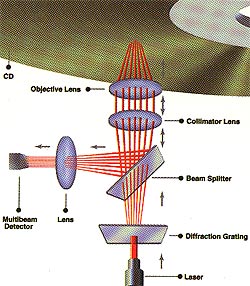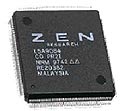Drive Specs:
|
Drive Specifications
Drive Interface
- EIDE/ATAPI
Disc Loading
- Motorized Tray
Disc Readable Formats
- CD-ROM Mode 1 and Mode 2
- CD-R
- CD-RW
- CD-Extra
- CD-DA
Audio
- Photo CD (Single- and
Multi-Session)
- CD-I/FMV
-
Video CD
- CD-ROM-XA
Disc Diameter
- 8cm and 12cm
Optical Beam Reader
- Kenwood 7-Beam Pickup
Data Transfer Rate
- 6,750 to 10,800 KB/sec. (typical*)
Burst Data Transfer Rate
-
16.6 MB/sec. (PIO Mode 4 and
DMA Mode 2)
-
33 MB/sec. (Ultra DMA)
Access Time (1/3 Stroke)
-
Less than 100ms (typical)
Within 7 Track Band
- 5ms
Data Buffer
- 2,048KB |
General Specifications
Eject Button
- Motorized Eject Button
- Emergency Hole
LED
- Access LED
Headphone Jack
- 3.5mm Stereo Mini-Jack
Volume Control
- Wheel Knob
CD-Audio Analog Out
- Supported
EIDE Settings
- Master, Slave, CSEL Jumper Settable
Installation
Orientation
-
Horizontal or Vertical (Using Locking Tabs)
Dimensions (W/H/D)
- 14.9 x 4.3 x
20cm (5.9 x 1.7 x 7.9in)
Weight
- 2.05lbs (.93kg)
Warranty
- 1 year
System Requirements
- Intel's 440LX chipset or better (or
equivalent) is recommended for best results
- 233 MHz
Pentium, 32 MB RAM |
xxxxxxxxxxxxxxxxxxxxxxxxxxxxxxxxxxxxxxxxxxxxxxxxxxxxxxxxxxxxxxxxxxxxxxxxx
Zen and the power of multibeam
pickups
As we all know by now, this CD-ROM is based on a technology called True-X, developed
by ZEN Research. Based in Israel and the States, Zen Research develops
new technology for use in cutting-edge components for CD and DVD
drives. The technology included in this drive includes optics, a detection
device, and a high speed processor.

So what does this
technology do that makes it so different from normal optics and processors
resident in a standard drive? To answer that question we must take a step
backward for a moment. Previous CD-ROM technologies relied upon one
highly-focused laser reading the encoded information off of the CD-ROM. In order
to boost the X-rating of the drive the rotational speed of the disc had to be
increased. Spin the disc faster and the laser is able to pickup
more data per second.
Based upon the Constant Angular Velocity
(CAV) format; 72X Kenwood Drive rotates the disc at an essentially
constant velocity. Data rates fluctuate in relation to where the laser is at any
one moment. Traditionally, the closer to the inside tracks the lower the data
rate achievable. This is because the disc must spin faster for the laser to
process the same amount of data as at the outside edge of the disc.
 Enter the technology developed by Zen. Instead
of rotating the disc above and beyond the physical limits by some act of magic,
they have devised a means to read seven tracks concurrently. Those seven streams
of data flow through a specially designed RISC chip and to your computer
with no additional CPU-load.
Enter the technology developed by Zen. Instead
of rotating the disc above and beyond the physical limits by some act of magic,
they have devised a means to read seven tracks concurrently. Those seven streams
of data flow through a specially designed RISC chip and to your computer
with no additional CPU-load.
Technically speaking here is what occurs as
your copy of Quake III spins up. A focused laser makes its way through a
diffraction grating where it is split into seven discrete beams. These seven
beams are spaced evenly to read seven tracks on the CD. As the beams make their
way to the disc they pass through a beam splitter and objective
lens. Conventional technology takes care of the focus and
tracking, and the returning beam is read by a special multi-beam detector
array. With the laser light converted to electrical signals the next
step in Zen's technology steps into the light.
 A purpose built parallel processor (ASIC) takes all
seven feeds of data and processes the optical signals at the same moment. The
end result is that a massive amount of data is processed quickly, without
overloading the CPU. The parallel processing ASIC integrates multiple channels
of analog front end inputs, DPLL, data encoding, error checking, parallel to
serial conversion, and UDMA ATAPI interface protocols. As a result data flow is
through the dedicated processor and the CPU is free to do more important
tasks.
A purpose built parallel processor (ASIC) takes all
seven feeds of data and processes the optical signals at the same moment. The
end result is that a massive amount of data is processed quickly, without
overloading the CPU. The parallel processing ASIC integrates multiple channels
of analog front end inputs, DPLL, data encoding, error checking, parallel to
serial conversion, and UDMA ATAPI interface protocols. As a result data flow is
through the dedicated processor and the CPU is free to do more important
tasks.
Transfer rates of 6 to 11Mb/s are achievable
currently with this Zen technology, and the company has plans to up that number
even further with the introduction of Blue laser optical hardware.
